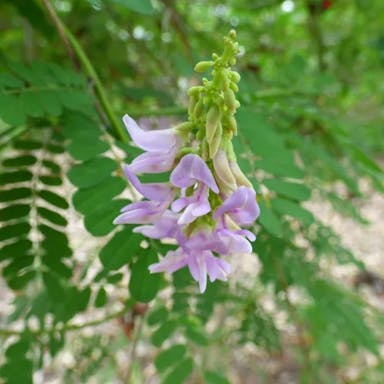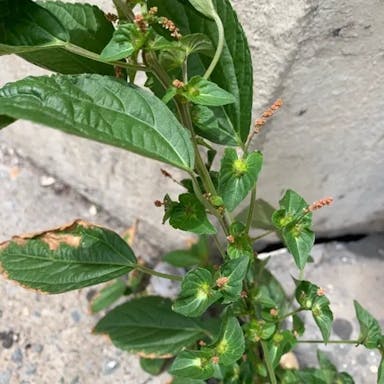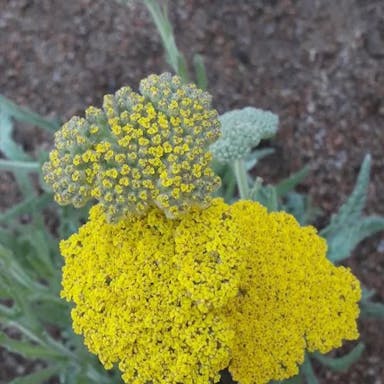Crested wheatgrass, scientifically known as Agropyron cristatum, is a perennial grass species that belongs to the Poaceae family. But the underside of its leaves are slick. The plant has a tufted growth habit with erect stems that can reach a height of 60-90 cm. The flowers hide are typically green or purplish in color and are wind-pollinated. Crested wheatgrass spreads its lodged branches in dry and semi-arid regions. It is known for its ability to tolerate drought, heat, and poor soil conditions. It is commonly used for reclamation of disturbed lands, as it has a deep root system that helps prevent soil erosion. In terms of cultivation, crested wheatgrass is relatively easy to grow and maintain. It can be propagated through seeds or vegetative methods. It is important to note that there are several varieties of crested wheatgrass, each with its own specific characteristics and adaptations. Overall, Agropyron cristatum, or crested wheatgrass, is a versatile and resilient plant that plays a significant role in land restoration and forage production.
Crested wheatgrass
- Scientific name
- Agropyron cristatum
Basic Information
- Poaceae Family Agropyron Genus Crested wheatgrass Species
- Poaceae > Agropyron > Agropyron cristatum
- 83%
- The Completeness of This Encyclopedia
Please help us complete the encyclopedia, Terrarium is a encyclopedia service to be completed with everyone in the world. Currently, this page is 83% complete. For more information on how to contribute, please click here.
- Forb/herb
- Graminoid
- Height
- 30cm ~ 90cm
- Flower Color
- Leaf Color
- Anthesis
- summer
- Sunlight Exposure
Full Sun Long hours of sunlight from morning to afternoon Partial Shade A location in the shade of a tree or where either the morning or afternoon is shaded Full Shade A place where there is no direct sunlight
- Full Sun
- Hardiness Zones
This is an indicator to know to which zone each plant can winter. Knowing the zone of each plant gives you an idea of the cold temperature resistance when grown in the ground without a roof. 2: -42.7 to -40.0 3: -39.9 to -34.4 4: -34.3 to -28.9 5: -28.8 to -23.3 6: -23.2 to -17.8 7: -17.7 to -12.2 8: -12.1 to -6.7 9: -6.6 to -1.1 10: -1.0 to 4.4 11: 4.5 to 10.0
- 3-9
- Cold resistance
- Excellent
- Heat resistance
- Fair
- Habitat of origin
- China, Mongolia, Russia
- Growth Rate
- Fast
What is Crested wheatgrass (Agropyron cristatum)?
What is Crested wheatgrass (Agropyron cristatum)
Flower meaning
The flower language commonly associated with Crested wheatgrass in America is
Calendar of Crested wheatgrass (Agropyron cristatum)
Calendar
Crested wheatgrass (Agropyron cristatum) is a perennial grass native species to Europe and Asia. In the United States, it is commonly found in western the states, particularly in the Great Basin and Intermountain regions. The period when Crested wheatgrass blooms typically occurs in late spring to early summer, usually from May during June. At this time, the Crested wheatgrass displays its flowers fully. The blooming time can vary depending on location and conditions. Crested wheatgrass blooms for a few weeks. However, temperature, moisture, and sunlight affect the duration. To encourage longer blooming, provide optimal conditions like sunlight, water, and soil fertility. Removing competing plants helps too. Overall, Crested wheatgrass shows its flowers in late spring to early summer.
How to grow Crested wheatgrass (Agropyron cristatum)
Watering
Crested wheatgrass, a perennial bunchgrass, requires regular watering to thrive. The optimum frequency of irrigation depends on the weather and soil conditions. As the growing season, which typically includes spring to fall, the foliage should be watered every 7-10 days. This frequency ensures that the dirt remains consistently damp but not soaked. In contrast, during the dormant period, which occurs in winter, watering should be reduced to once every 3-4 weeks. This enables the shrub to conserve energy and adapt to lower humidity levels. It is important to observe soil humidity to avoid overwatering or underwatering. The total water required per irrigation session should be approximately 1 inch, ensuring profound penetration into the soil to encourage root development. Regular irrigation, adhering to these instructions, will help sustain the health and vigor of Crested wheatgrass.
Soil and Fertilizer
Crested wheatgrass, scientifically known as Agropyron cristatum, which grows well in a range of soil quality. It prefers drained soils. The soil contain good organic matters. To ensure best growth, it is good to put fertilizer during early spring or fall. A balanced fertilizer with 3:1:2 ratio of nitrogen (N), phosphorus (P), potassium (K) is good for crested wheatgrass. The amount of fertilizer depends on the soil and plant needs. Doing a soil test can determine the right amount of fertilizer required. Fertilizer should spread evenly over the top soil surface. It is important not to use too much fertilizer, as it can cause problems and pollution. Checking soil and plant growth regularly is key to adjust fertilizer rates as required. By providing optimal soil and fertilization, crested wheatgrass can grow well and help stabilize soil and produce forage.
Sunlight and Place
Crested wheatgrass, plant commonly applied for watercourse charge decrease and feed fabrication, exhibits an acceptably cold-natured flora. It can persist frosty under -20°C (-4°F) without vast disfigurement. Although, unfit for locales with severely icy winters. Regarding hot impression, Crested wheatgrass is designed for arid, torrid atmospheres. It can bear heat up to 40°C (104°F) without contrary goods. The finest heat bracket for the flora is amid 15°C (59°F) and 25°C (77°F). During summertime, Crested wheatgrass needs complete sunlight uncovering to augment maturation likely. A sun worshipper that prospers in sectors with no fewer than 6 to 8 hours of straightforward sunlight daily. Regarding placement, prescribed to embed Crested wheatgrass in well-drained mud with effective sunlight uncovering. During wintertime, vital to assure the flora is guarded from utmost frosty to impede impairment. By and large, Crested wheatgrass is an elastic flora that can bear a broad heat bracket and thrives in complete sunlight provisions.
Advanced Information of Crested wheatgrass (Agropyron cristatum)
Pruning
Crested wheatgrass, scientifically known as Agropyron cristatum, is a perennial grass species commonly used for forage and erosion control. If you want the plant to be shorter or get rid of dead or damaged leaves, you can cut it back in early spring before new growth starts. Use clean, sharp pruning shears to cut the stems to the height you want, leaving about 2-3 inches of leaves. Be careful not to cut too close to the bottom of the plant so you don't hurt it. After cutting, take away and throw out the cut pieces properly. It's important not to cut back or prune too much because that can make the plant weak and hurt its health and strength. So you should only cut back Crested wheatgrass when you really need to, and avoid cutting away too much.
Planting and Harvest
Crested wheatgrass, scientifically known as Agropyron cristatum, is a grass used for erosion control. Prepare soil by removing weeds. Sow seeds on surface, water after planting. Keep moist until germination. Plants need little maintenance. Water during dry periods, fertilize sometimes. Avoid overwatering or over-fertilizing. Repot when dormant in fall or spring. Lift plant, loosen roots, place in larger pot with fresh soil. Water after repotting. Provide proper care. Mishowing is planting it in a pot, not ground. This restricts roots and development. Crested wheatgrass is for soil and forage, not a potted plant.
Propagation
Crested wheatgrass can be propagated through various methods such as sowing seeds, division, and cuttings. Soil preparation must be proper for division, sowing, and cutting propagation. Provide sunlight, regular watering for seed germination. Leaf cuttings should have a vein. Plant leaf cuttings in well-draining medium. Maintain indirect light and warmth for root development. Cut seed heads when seeds mature. Allow drying before seed collection. Protect new plant growth until well established.
Pests and Diseases
Crested wheatgrass (Agropyron cristatum) is susceptible to several pests and diseases. The common diseases include stripe rust, causing yellowish-orange stripes on the leaves. To prevent, regular monitoring and early detection are crucial. Another disease is leaf rust, causing small, reddish-brown pustules on the leaves. Similar to stripe rust, monitoring and early detection helps manage leaf rust. In terms of pests, crested wheatgrass can be susceptible to aphids. Aphids can cause stunted growth and yellowing of leaves. Regular scouting and use of insecticides, if necessary, can help control aphid populations. It is important to note susceptibility varies depending on cultivar and conditions. Consulting local experts is recommended for management strategies.
Habitat of Crested wheatgrass (Agropyron cristatum)
Habitat
Toxicity of Crested wheatgrass (Agropyron cristatum)
Health Benefits
- edible
- Inedible
- Toxic
- No toxicity
NO DATA
Toxic for dogs and cats
NO DATA
Q&A of Crested wheatgrass (Agropyron cristatum)
- Where can you find Crested Wheatgrass seed for sale?
Crested Wheatgrass seeds, known as Agropyron cristatum, are available at online stores selling seeds. Local stores may also sell these. Check if the seeds suit your needs.
0
0
- What are the best practices for growing Crested Wheatgrass from seed?
For sound germination of Crested Wheatgrass (Agropyron cristatum), initially ensuring a weed-free and rival vegetation-free seedbed is vital. The earth should be lightly worked to construct an excellent, stable seedbed. Embed the seeds in the early springtime or late fall season, at a depth of around 1/4 to 1/2 inch. The seed quantity should be about 15 to 20 pounds per acre. Confirm the seeds get suitable wetness, particularly during germination. Frequent watering is essential, but avoid overwatering as it can prompt seed decay. Lastly, realize that Crested Wheatgrass is a gradual growing plant, so endurance is fundamental. It might take a couple of years for the plants to completely establish and attain maximum efficiency.
0
0
- How can you grow a Crested Wheatgrass lawn?
To develop a lawn of Crested Wheatgrass, start preparation by tilling the dirt and getting rid of unwanted plants or stones. Then, in early spring or late fall when the temperature is around 15-20 degrees Celsius, scatter the seeds of Agropyron cristatum, the scientific name for Crested Wheatgrass. Give the seeds a gentle but steady amount of water, making sure the soil stays damp but not flooded. As the grass starts to develop, reduce watering to once per week, letting the soil dry out in between. Feed the lawn yearly with a high-nitrogen fertilizer to help healthy increase. Regular trimming will also assist in keeping a tidy look and encourage thicker growth.
0
0
- Is there a recommended way to choose Crested wheatgrass?
Crested wheatgrass, scientifically known as Agropyron cristatum, is a popular plant used for erosion control, forage production, and reclamation purposes. When selecting varieties of Crested wheatgrass. For example, the Hycrest known for its high seed production and good forage quality, making it suitable for livestock grazing. Fairway is another variety that is commonly used for turf and golf course applications due to its fine texture and dense growth habit. When purchasing seeds, it is recommended to choose certified seeds that have been tested for purity and germination rate. Additionally, selecting seedlings that are healthy and disease-free is crucial for successful establishment. It is advisable to consult with local agricultural extension services or reputable nurseries for specific recommendations on varieties, seeds, and seedlings suitable for your region.
0
0











